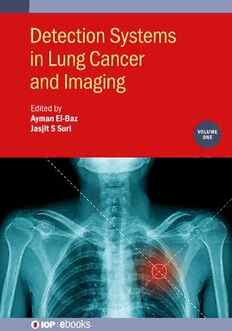Table Of ContentDetection Systems in Lung
Cancer and Imaging, Volume 1
Detection Systems in Lung
Cancer and Imaging, Volume 1
Edited by
Ayman El-Baz
University of Louisville, Louisville, Kentucky, USA and
University of Louisville at AlAlamein International University (UofL-AIU),
New Alamein City, Egypt
Jasjit S Suri
AtheroPoint LLC, Roseville, CA, USA
IOP Publishing, Bristol, UK
ªIOPPublishingLtd2021
Allrightsreserved.Nopartofthispublicationmaybereproduced,storedinaretrievalsystem
ortransmittedinanyformorbyanymeans,electronic,mechanical,photocopying,recording
orotherwise,withoutthepriorpermissionofthepublisher,orasexpresslypermittedbylawor
undertermsagreedwiththeappropriaterightsorganization.Multiplecopyingispermittedin
accordancewiththetermsoflicencesissuedbytheCopyrightLicensingAgency,theCopyright
ClearanceCentreandotherreproductionrightsorganizations.
PermissiontomakeuseofIOPPublishingcontentotherthanassetoutabovemaybesought
[email protected].
AymanEl-BazandJasjitSSurihaveassertedtheirrighttobeidentifiedastheeditorsofthiswork
inaccordancewithsections77and78oftheCopyright,DesignsandPatentsAct1988.
ISBN 978-0-7503-3355-9(ebook)
ISBN 978-0-7503-3353-5(print)
ISBN 978-0-7503-3356-6(myPrint)
ISBN 978-0-7503-3354-2(mobi)
DOI 10.1088/978-0-7503-3355-9
Version:20220101
IOPebooks
BritishLibraryCataloguing-in-PublicationData:Acataloguerecordforthisbookisavailable
fromtheBritishLibrary.
PublishedbyIOPPublishing,whollyownedbyTheInstituteofPhysics,London
IOPPublishing,TempleCircus,TempleWay,Bristol,BS16HG,UK
USOffice:IOPPublishing,Inc.,190NorthIndependenceMallWest,Suite601,Philadelphia,
PA19106,USA
With love and affection to my mother and father, whose loving spirit sustains me still
—Ayman El-Baz
To my late loving parents, immediate family, and children
—Jasjit S Suri
Contents
Preface xiii
Acknowledgement xiv
Editor biographies xv
List of contributors xvi
1 Lung cancer classification using wavelet recurrent 1-1
neural network
Devi Nurtiyasari, Dedi Rosadi and Abdurakhman
1.1 Introduction 1-1
1.2 Lung cancer and lung image 1-2
1.2.1 Lung cancer 1-2
1.2.2 Lung image 1-2
1.2.3 Image processing 1-6
1.3 Classification process 1-7
1.3.1 Classification 1-7
1.3.2 Features extraction 1-8
1.3.3 Wavelet 1-11
1.3.4 Machine learning 1-16
1.3.5 Neural network 1-16
1.3.6 Recurrent neural network 1-22
1.3.7 Mean square error 1-22
1.3.8 Sensitivity, specificity, and accuracy 1-22
1.4 Dataset 1-23
1.5 Modeling wavelet recurrent neural network for lung cancer nodule 1-25
classification
1.5.1 Image denoising using wavelet 1-25
1.5.2 Wavelet recurrent neural network for lung cancer classification 1-26
1.6 Results and discussion 1-28
1.7 Conclusion 1-30
References 1-30
2 Diagnosis of diffusion-weighted magnetic resonance imaging 2-1
(DWI) for lung cancer
Katsuo Usuda and Hidetaka Uramoto
2.1 Introduction 2-1
vii
DetectionSystemsinLungCancerandImaging,Volume1
2.2 Diagnosis of lung cancer and the pulmonary nodules and 2-1
masses (figures 2.1–2.6, table 2.1)
2.3 Diagnostic capability of nodal involvement in lung cancer 2-4
(figures 2.7–2.9)
2.4 Recurrence or metastasis from lung cancer (figure 2.11) 2-7
2.5 Diagnosis of lung cancer by whole-body DWI 2-8
2.6 Response evaluation to chemotherapy and/or radiotherapy 2-8
(figure 2.11, table 2.2)
2.7 ADC and pathology 2-8
2.8 Medical cost of examinations 2-9
2.9 Advantage and disadvantage of MRI 2-10
2.10 Future plans 2-10
2.11 Conclusion 2-10
References 2-10
3 Computer assisted detection of low/high grade nodule from 3-1
lung CT scan slices using handcrafted features
Seifedine Kadry and Venkatesan Rajinikanth
3.1 Introduction 3-1
3.2 Computer assisted detection system 3-4
3.2.1 Image collection 3-6
3.2.2 3D to 2D conversion 3-6
3.2.3 Threshold filter implementation 3-6
3.2.4 Nodule segmentation 3-8
3.2.5 Feature extraction 3-8
3.2.6 Feature selection 3-9
3.2.7 Classifier implementation 3-12
3.2.8 Validation of the CAD system 3-13
3.3 Results and discussions 3-14
3.4 Conclusion 3-17
References 3-17
4 Computer-aided lung cancer screening in computed 4-1
tomography: state-of the-art and future perspectives
Joa˜o Pedrosa, Guilherme Aresta and Carlos Ferreira
4.1 Introduction 4-1
4.1.1 Computer-aided lung cancer screening 4-5
viii
DetectionSystemsinLungCancerandImaging,Volume1
4.2 Computer-aided lung nodule detection 4-7
4.3 Computer-aided lung nodule segmentation 4-13
4.4 Computer-aided lung nodule characterization 4-16
4.4.1 Malignancy characterization 4-16
4.4.2 Other nodule features 4-19
4.5 Computer-aided lung cancer patient diagnosis/management 4-21
4.5.1 Lung cancer patient diagnosis 4-21
4.5.2 Patient follow-up recommendation 4-23
4.6 Available datasets 4-24
4.6.1 ANODE09 dataset 4-24
4.6.2 Lung image database consortium image collection dataset 4-25
4.6.3 Luna16 dataset 4-25
4.6.4 National lung screening trial dataset 4-26
4.6.5 Kaggle data Science Bowl 2017 dataset 4-26
4.6.6 LNDB dataset 4-26
4.7 Conclusion and future perspectives 4-26
References 4-30
5 Radiation therapy in lung cancer treatment 5-1
Mary McGunigal, Jonathan W Lischalk, Pamela Randolph-Jackson
and Puja Gaur Khaitan
References 5-9
6 Application of visual sensing technology in lung cancer 6-1
screening
Rongpeng Li, Yonghong Xu and Nana Xu
6.1 Introduction 6-1
6.2 Section 1: detection of lung cancer-related markers in exhaled breath 6-4
through the visual sensing technology
6.2.1 Definition of VOCs in exhaled breath 6-4
6.2.2 Production mechanism of lung cancer-related VOCs in 6-6
exhaled breath
6.2.3 Preparation method of sensor chip 6-7
6.2.4 Collection of lung cancer-related VOCs in exhaled breath 6-8
6.2.5 Analysis of VOC patterns 6-8
6.2.6 Computational formulas of the relative standard deviation 6-10
(RSD or %RSD) and concentrations of saturated vapor (C)
s
ix

